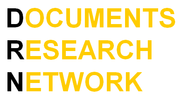Maria PournaraI’ll be honest – when I first started my PhD, I wasn’t planning to use documents as data. I envisaged a mixed-methods or even experimental design to explore the influence of rationality and bias on police decision-making in tackling organised crime. I was thinking of documents as something that would probably be part of my literature review; legislation or policy documents that drive decision-making, but not as ‘proper’, juicy, qualitative data. Even when, in a scoping interview with a potential participant during my first year, he showed me these documents (that I have now spent almost two years studying, analysing and reflecting on), I still thought ‘they look interesting, maybe they’ll be worth a read’. When I ran my first thematic analysis on them a few weeks later, I decided that they can be part of my theoretical framework and inform the next, ‘real’ part of my research. What I wasn’t realising, was that the documents – as any data inevitably does – had already driven my research to a different direction than the one I was hopelessly trying to hold on to. I didn’t happen to find them, they found me; and were begging to be discovered.
Reflecting on this first encounter with the reports that are now some of the units of analysis in my PhD, I realise that I had adopted the same misconception as many other social researchers who view documents as resources to gather information rather than as data which should be viewed as ‘collective social products’ (Prior, 2003). Documents are of particular importance in criminological research where typically impenetrable groups and organisations such as law enforcement or police forces might be difficult for students to access. The annual reports these agencies are required to produce, like the ones I’m analysing, can provide a plethora of detailed information on the structure and activities of an organisation (Noaks & Wincup, 2004). They can also reveal a great deal about the force’s relative priorities on crime control and their changes over time which is what I am trying to untangle in my research. This unexpected shift towards documentary methods has motivated me to organise a workshop on methodological approaches to document analysis funded by the GW4 alliance which brings together the universities of Cardiff, Bristol, Bath and Exeter and aims to provide researcher-led and innovative training to postgraduate students, among many other objectives. As a result I have already networked with many postgraduate researchers who are using, considering or have a general interest in documents as data. It has become evident to me that document analysis is one of the most widely used methods in social sciences research, yet even the training available to postgraduate researchers is very limited. This can be mainly attributed to a general attitude among social scientists that documents are merely ‘common sense’ versions of social phenomena that do not necessitate any particularly sophisticated scientific approach and analysis. As a result, many doctoral researchers do not feel entirely confident about using documents as data (they might only use them as resources instead) and do not reap their advantages: their ‘richness’ (Atkinson and Coffey (2011) argue that they form their distinct forms of ‘documentary realities’), demonstrations of ‘relevance and effect’, the fact that they are ‘naturally occurring’, and of course their ‘availability’ (Silverman, 2014). I am confident that the DRN will be an extremely useful platform for all these researchers to network, find training opportunities, seek support and information about methodological approaches to documents and generally discover their awesomeness to use as data – just like I did. References Atkinson, P., & Coffey, A. (2011). Analysing documentary realities. In D. Silverman, Qualitative Research (pp. 56-75). London: Sage. Noaks, L., & Wincup, E. (2004). Criminological Research - Understanding Qualitative Methods. London: Sage. Prior, L. (2003). Using documents in Social Research. London: Sage. Silverman, D. (2014). Doing Qualitative Research. London: Sage.
0 Comments
Leave a Reply. |
AuthorMembers of the Documents Research Network Archives
June 2019
Categories |

 RSS Feed
RSS Feed
